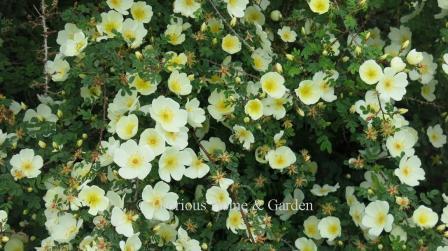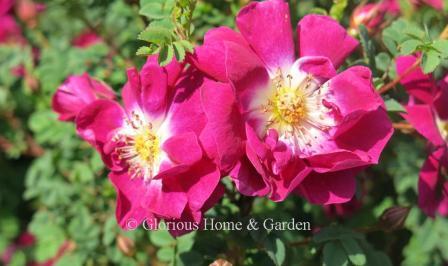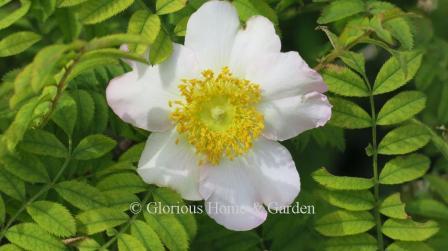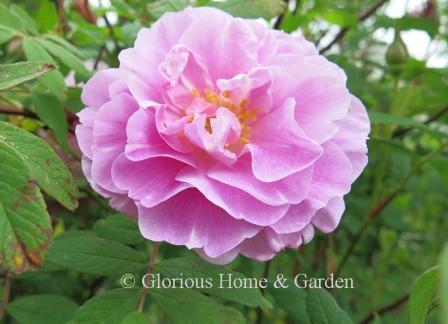- Home
- The Summer Garden
- Species Roses
Roses Make the Garden Glorious
Of all the flowers in the world, roses are the most beloved; their beautiful shapes, intoxicating fragrance, glorious colors and versatility make them irresistible. Nothing makes a garden more romantic or glorious than roses.

With so many types to choose from, there is something for every situation. Even though most of them require and thrive in full sun, there are some that do fairly well in partial shade. There are scented and unscented ones (but what is a rose without fragrance?), there are thorny and thornless ones, and there is nearly any color imaginable except blue and black (and hybridizers are working on those). The American Rose Society, located in Shreveport, Louisiana, classifies roses into three main groups—species, old garden, and modern.
“Whatever differences of opinion we may hold about roses, and whether our taste inclines to the hybrid teas, or to the ramblers or to the old shrub roses, there is one thing on which we are all in agreement: it is an advantage for a rose to smell like a rose.”
Vita Sackville-West
Species Roses
'Species roses are those that are found naturally in the wild. They have been cultivated for centuries for perfumery, medicinal and culinary uses. And they have been celebrated in poems, plays and art throughout history. Though most species bloom only once in spring, they bloom profusely and are usually wonderfully fragrant. They also tend to be very vigorous, disease-resistant, and require little attention. Crossing the wild species and their naturally occurring hybrids led to the development of the antique rose classes which led in turn to today’s modern hybrids.
Rosa banksiae, ‘Lady Banks’ rose, Zones 6-9. 'Lady Banks’ rose, in either it’s white or yellow form is a very vigorous climbing rose that can reach 15-20 feet, and thus is an excellent candidate for a trellis (sturdy) or arbor completely smothering it in spring in a cascade of white or yellow blooms. The individual flowers are small, but are borne in clusters and in great profusion. ‘Alba Plena,’ the white one, is said to have a stronger scent than ‘Lutea,’ the yellow one, redolent of violets. Both are very vigorous, thornless, and relatively pest-free. Mainstays of Southern gardens.
 Rosa banksiae 'Alba Plena'
Rosa banksiae 'Alba Plena' Rosa banksiae 'Lutea'
Rosa banksiae 'Lutea'Rosa eglanteria, eglantine rose or sweetbrier (also known as R. rubiginosa). The sweetbrier rose is a European native commonly seen in hedgerows in England and elsewhere. It also makes a lovely garden subject with its soft pink single flowers followed by large, red hips. It has a lovely fragrance, and even the leaves when crushed have a scent of apples. The shrub can grow to 8-10’, but can be maintained at a lower height. Shakespeare references eglantine and other roses throughout his plays.
“I know a bank where the wild thyme blows, Where oxlips and the nodding violet grows, Quite over-canopied with luscious woodbine, With sweet musk-roses and with eglantine: There sleeps Titania sometime of the night, Lull’d in these flowers with dances and delight.” (A Midsummer Night’s Dream, Act I, Scene 2, William Shakespeare)
Rosa glauca, redleaf rose (also known as R. rubrifolia or R. ferruginea), Zones 2-8. Though it is called the redleaf rose, the foliage of R. glauca is really a soft bluish or grayish-green with reddish undersides. The foliage is beautiful and distinctive. The color is best with a little shade, but remembering that roses mush have their quota of sun. It has single pink flowers followed by red-brown hips in fall. Not much scent, but the shrub is nearly thornless which makes it friendlier to the gardener than some, and that combined with the lovely foliage color and hardiness make it a rose for every garden.
 Rosa glauca
Rosa glaucaRosa hugonis, Father Hugo’s rose, Zones 5-9. Father Hugo’s rose, or the Yellow Rose of China, as it is also known, is an extremely important rose in the history of hybridization because it introduced yellow into the genetic pool. A lovely rose in its own right, it is a soft buttery yellow with fine, ferny foliage and grows to 8-9.’ It blooms only once, in late spring, but prolifically.
 Rosa hugonis, Morris Arboretum, public domain
Rosa hugonis, Morris Arboretum, public domainRosa laevigata, Cherokee rose, Zones 7-9. The flowers of the Cherokee rose are single, large, pure white, and fragrant. There is only one flush of blooms in the spring, but it is profuse, produced on long canes that can reach 30 ft., or more. Introduced into this country from China in the 18th c., the Cherokee rose has become naturalized in the Southeast and is considered invasive in some areas. It is the State Flower of Georgia.
 Rosa laevigata, the Cherokee rose
Rosa laevigata, the Cherokee roseRosa moschata, musk rose, Zones 6-10. One of the most fragrant species of roses, the musk rose has been used in the development of several classes of roses including the Damasks and Noisettes. The double form is R. moschata ‘Plena.’ Both single and double forms have the distinction of blooming in late summer into fall, making them most welcome at that time of year.
 Rosa moschata, Pierre-Joseph Redouté, public domain
Rosa moschata, Pierre-Joseph Redouté, public domainRosa moyesii, Moye’s rose, Zones 5-9. This red rose from China was introduced in 1908 and it is noted not only for the bright red single flowers, but for the large, decorative, vase-shaped hips that follow in late summer. This is a rose that can reach about 12 feet, so it is not the best choice for a small garden.
Rosa palustris, swamp rose, Zones 4-9. The swamp rose is native to eastern North America where it can be found on stream banks, boggy areas, and pond edges, thus it is a good candidate for gardens with damp areas and full sun. Fragrant deep pink single to semi-double flowers appear in late spring into mid-summer and are followed by small red hips that birds will devour. The foliage often turns lovely shades of red in autumn.
 Rosa palustris
Rosa palustrisRosa pimpinellifolia and hybrids, Burnet rose or Scots rose (also known as R. spinosissima), Zones 3-9 This wild rose is exceedingly prickly. It is low growing to about 20,” though variants and hybrids may be taller. A distinguishing feature is the large purple hips that ripen in the fall. A vigorous grower, it spreads readily by suckers and underground stolons. Native to northern Asia and Europe. Hybrids include ‘Grandiflora’ (also known as 'Altaica') with large white flowers; ‘Dunwich,’ a variant of ‘Grandiflora,’ but smaller; ‘Stanwell Perpetual’ is pale pink and is named for its continuous blooming ability; ‘William III’ is a dwarf shrub with bright deep pink flowers and the purple hips common to the species.
 Rosa pimpinellifolia 'Grandiflora'or 'Altaica'
Rosa pimpinellifolia 'Grandiflora'or 'Altaica' Rosa pimpinellifolia 'Dunwich'
Rosa pimpinellifolia 'Dunwich' Rosa 'Stanwell Perpetual'
Rosa 'Stanwell Perpetual' Rosa 'William III"
Rosa 'William III"Rosa roxburghii var. normalis, burr rose or chestnut rose, Zones 6-9. This is the single form of the chestnut rose, and looks quite different from the double form with its white to soft pink coloring. The small leaves grow opposite each other in a ladder-like pattern.
 Rosa roxburghii var. normalis
Rosa roxburghii var. normalisRosa roxbughii var. plena chestnut rose, Zones 6-9. The chestnut rose is a species of rose that originated in China. The flower is tightly packed with petals, sometimes incurved like a chrysanthemum, but it is the hips that look like the outward coverings of chestnuts that give this species its common name. The leaves are different from the typical rose, being made up of many small leaflets. The chestnut rose blooms in the spring, it does very well in the South and is quite disease-resistant.
 Rosa roxburghii
Rosa roxburghiiRosa rugosa, beach rose, Zones 2-7. Deep pink fragrant flowers start in late spring and continue intermittently until frost and are followed by large red hips. The deeply veined leaves are distinctive. These are tough, cold-hardy, healthy roses and do exceptionally well near the seashore. ‘Alba’ is the white sport of Rosa rugosa. See rugosa hybrids below.
 Rosa rugosa
Rosa rugosa Rosa rugosa 'Alba'
Rosa rugosa 'Alba' Rosa rugosa 'Alba' hips
Rosa rugosa 'Alba' hipsHybrid Rugosa Roses: Rosa rugosa is noted for its vigor, disease resistance, adaptability to seaside conditions, and fragrance, but also for its thorniness and tendency to sucker and form colonies. Hybridizers have attempted to create new forms using R. rugosa and other species and hybrids to retain the best qualities and minimize the less desirable ones, but it seems that prickliness and suckering are dominant traits. However, those qualities also make them superb for barriers, erosion control, hedges, and cottage garden subjects. They are long-blooming, have lovely fragrance, and most have exceptionally large hips that are superb for making jams and jellies. Rugosa hybrids and derivatives include ‘Agnes,’ yellow; ‘Blanc Double de Coubert,’ white; ‘Conrad Ferdinand Meyer,’ light pink; ‘Parfum de l’Hay,’ crimson red; ‘Roseraie de L'Hay,’ magenta; ‘Sarah Van Fleet,’ pink; ‘Sir Thomas Lipton,’ white; ‘Thérèse Bugnet,’ pink and nearly thornless; ‘Topaz Jewel,’ yellow.
 Rosa 'Parfum de l'Hay'
Rosa 'Parfum de l'Hay' Rosa 'Roseraie de L'Hay'
Rosa 'Roseraie de L'Hay' Rosa 'Therese Bugnet'
Rosa 'Therese Bugnet' Rosa 'Topaz Jewel'
Rosa 'Topaz Jewel'Rosa villosa, apple rose, Zones 5-9. Also called Rosa pomifera. The apple rose has several excellent characteristics going for it. It has lovely blue-green foliage and long canes that tend to arch over. The single, soft pink flowers with white at the base appear in early summer and are followed in the autumn by large, highly ornamental, bright red hips.
 Rosa villosa
Rosa villosaRosa virginiana, Virginia rose or prairie rose, Zones 3-8. This Eastern North American native is very tough and grows well under varied conditions. It is very cold-hardy, is not fussy as to soil type, and like Rosa rugosa, tolerates seaside conditions well. The single pink flowers are followed by red hips, and as an added bonus the foliage turns bright red in autumn as well. Due to the plants suckering habit, it can form a goodly-sized colony over time, so it does need room.
 Rosa virginiana
Rosa virginianaPlant of the Month

Ilex verticillata
Winterberry holly
Updated new USDA Plant Hardiness Zone Map 2023.